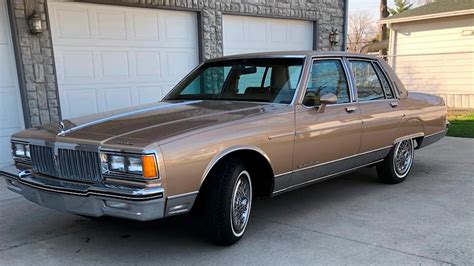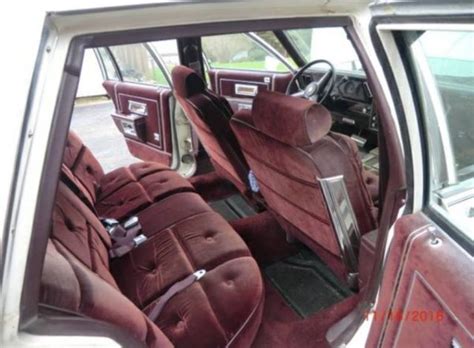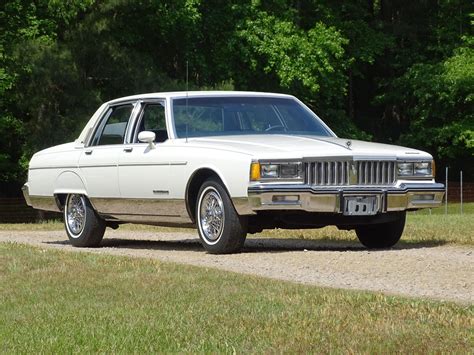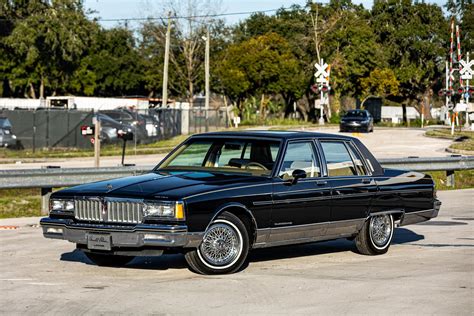1985 Pontiac Parisienne problems

The Pontiac Parisienne is a full-size rear-wheel drive vehicle that was sold by Pontiac on the GM B platform in Canada from 1958 to 1986 and in the United States from 1983 to 1986. Right-hand drive models were locally assembled in Australia, New Zealand, and South Africa until 1969. For most of its run, the Canadian Parisienne was nearly mechanically identical to the American Chevrolet Impala or Chevrolet Caprice. The Parisienne wagon continued under the Safari nameplate until 1989. Parisienne or La Parisienne means a grammatically female person or thing from Paris, France.
Differences from US Pontiacs
The Parisienne entered the production lineup as a sub-series within the Laurentian line in the 1958 model year. Parisienne became a separate model in 1959.
For most of its life, the Parisienne was the Canadian nameplate for the top-of-the-line model sold in GM of Canada's Pontiac showrooms. Parisiennes were distinct from other Canadian Pontiac models by their standard features: the luxuriousness of upholstery fabrics; standard equipment such as courtesy interior and trunk lights; bright trim mouldings in the interior; distinct exterior accent chrome pieces; and availability of two- and four-door hardtops and convertibles.
In particular, Canadian "full size" Pontiacs were actually closely related to Chevrolets, making use of the economical Chevrolet chassis and drivetrain, though with the American Pontiac-styled exterior body panels (They weren't the same as U.S. Pontiac panels since they had to fit the shorter-wheelbase 119-inch Chevrolet "X" frame. U.S. Pontiacs used a full perimeter frame.) and interior instrument panels. As Chevrolets under the skin, Canadian Pontiacs including the Parisienne used the same engines and transmissions as full-size Chevys, including the 230 and 250 cubic inch 6 cylinder and 283, 307, 327, 350, 396, 400, 409, 427 and 454 cu inch V8s. These engines were mated to the same transmissions as Chevrolet, including 3 and 4 speed manual and the 2 speed Powerglide and later the three-speed Turbo Hydra-Matic automatic transmissions.
The first Parisienne, offered for the 1958 model year, was a super deluxe "halo" model in the Laurentian line, much like Chevrolet's Bel Air Impala of the same year. Chevrolet's Ramjet fuel injection system, introduced in 1957 in the U.S., was a Parisienne option as well. It was marketed as the "Power Chief" option, but it was identical to Chevy's Ramjet. Also available for the first year Parisienne was Chevrolet's Turboglide automatic transmission.
Built in the same GM of Canada assembly plant in Oshawa, Ontario, Pontiacs had parallel model lineups as "full size" Chevrolets: the Pontiac "Strato Chief" had similar trim level and upholstery as Chevrolet's "Biscayne", the "Laurentian" matched the trim level of the Chevrolet "Bel Air" and while the Parisienne offered similar amenities as Chevrolet's "Impala", the Pontiac version had unique and more costly upholstery fabrics, and beginning in 1964 the "Custom Sport" (later rebadged the "2+2") two-door hardtop and convertible model line was in lock-step with Chevrolet's "Super Sport". Finally, starting in 1966 Pontiac offered the "Grande Parisienne", in two-door and four-door hardtop models parallel to Chevrolet's luxurious "Caprice," although Grande Parisiennes through 1967 used the styling of the US-market Grand Prix. Also for 1967 and 1968 a Grande Parisienne wagon was offered. Through most of its life, the Parisienne resembled the US-market Bonneville despite its Chevrolet underpinnings.
In contrast, the Pontiac Motor Division of GM in the US manufactured models with drivetrains, chassis and equipment unique from the other GM stablemates—Chevrolet, Oldsmobile, Buick, and Cadillac. Through much of the 1950s through 1970s, the American Pontiac model lineup included the "Catalina", "Ventura", "Executive", "Star Chief" and as the top of the line model, the "Bonneville". Additionally, unique to the US lineup until 1969 was the "Grand Prix", a distinct 2-door hardtop model with unique styling features and both luxury and "sporty" accoutrements such high output V8s, bucket seats, tachometers and flashy trim pieces.
The mix of Pontiac exterior styling on an economical Chevrolet chassis and drivetrain at a price point marginally higher than Chevrolet, was a huge marketing success for GM of Canada. For decades "full-size" Pontiacs took third place behind Chevrolet and Ford in sales, typically 70,000 plus units annually. In contrast, heavier and bulkier American Pontiacs, with far higher sticker prices and higher operating costs due to large displacement V8s requiring high octane fuel, would have little appeal in the Canadian marketplace for a number of reasons: a population base one tenth the size of the US, a less stratified society with lower disposable incomes, more prudent spending and savings sensibilities and far higher taxes and gasoline prices. On the manufacturing side, maintaining unique part availability for a low-sales vehicle along with import-export tariffs and barriers between the U.S. and Canada would make the sale of American Pontiacs unprofitable in Canada.
In 1977, GM downsized its full-sized lineup. Pontiac continued with the Catalina and Bonneville nameplates it had used since 1973, but the cars failed to manage the sales volume of their divisional siblings and were dropped completely in 1981. However, the Bonneville name was then simply switched to the smaller G-body Pontiac (the cousin of the Chevrolet Malibu, Oldsmobile Cutlass, and Buick Regal) for 1982. Previously, those cars had been sold as the LeMans, but sales were poor and GM decided to swap nameplates on the grounds that Bonneville carried higher name recognition among customers.
With the recession of 1979–82 lifting and gas prices beginning to drop, sales of larger cars began to pick up and so Pontiac dealers began demanding the return of the full-sized B-body line. However, the assembly plants used for the Catalina/Bonneville had been converted over to other uses, thus GM had to now source Pontiac B-bodies from Canada, where the line had not been discontinued.
Even though the re-sized Bonneville was also sold in Canada, the full-size Parisienne continued for 1982, although its distinct Pontiac front- and rear-end treatments and interiors were largely replaced with Chevrolet components (described in detail below). At the request of US Pontiac dealerships who still wanted a full-size rear wheel drive car to replace the lost U.S. market share and gain back traditional Pontiac customers who longed for a large rear wheel drive car, the Parisienne was imported from Oshawa, Ontario, Canada and sold in the United States beginning in the 1983 model year, retaining the model name "Parisienne" and specs from the Canadian original. Externally, it was a rebadged Chevrolet Impala (1983-84 models (and 1982 in Canada) had the Impala rear taillight panel fitted with Pontiac-spec taillight lenses, whereas the nose was borrowed from the Chevrolet Caprice fitted with a Pontiac grille). The 1985 and 1986 models resumed use of the rear-end styling from the 1980 to 1981 Bonneville. Two Parisienne ranges were sold: a base model (similar to the former Catalina and the then-current Oldsmobile Delta 88 Royale) in four-door sedan and Safari station wagon form, and a more-luxurious Brougham four-door sedan (with velour upholstery that featured loose-pillow fitted seats). The two-door version of the 1977-81 B-bodies did not return to the US market, although it persisted in Canada through 1983.

Social links
Common 1985 Pontiac Parisienne problems
The 1985 Pontiac Parisienne has been reported to have various issues, with the most common problems centering around the transmission and engine.
Transmission Problems:
The 1985 Pontiac Parisienne's transmission can exhibit issues such as shifting delays, grinding when accelerating, a shaky feeling, or whistling noises accompanied by a burning smell emanating from under the hood.
Engine Problems:
The 1985 Pontiac Parisienne's engine can be challenging to start, especially if the car has been sitting for an extended period. This issue can be attributed to high compression or a partially seized engine, making it difficult to turn over manually with a bar.
Another engine-related issue is misfiring, which can be felt as a hesitation from a complete stop and while driving. This problem can be caused by various factors, such as a faulty PCV, worn-out spark plugs, a malfunctioning distributor, or issues with the carburetor or HEI ignition system.
To address these engine problems, it is recommended to perform regular maintenance checks, such as replacing the spark plugs, distributor cap, and wires, and ensuring that the timing is correct. Additionally, checking for vacuum leaks and inspecting the carburetor and HEI ignition system can help identify and rectify the issues.
In summary, the 1985 Pontiac Parisienne has common problems related to the transmission and engine. Regular maintenance checks and timely repairs can help mitigate these issues and ensure the car's longevity and performance.

How much does a 1985 Pontiac Parisienne weight?
Anyway, the Parisienne wagon has a wheelbase of 116 inches; overall length, 215 inches; width, 79.3 inches; height, 57.4 inches, and curb weight, 3,650 pounds. Even by 10-year-old standards, it is still a good-sized car.
What was the last year of the Pontiac Parisienne?
1986
The Pontiac Parisienne is a full-size rear-wheel drive vehicle that was sold by Pontiac on the GM B platform in Canada from 1958 to 1986 and in the United States from 1983 to 1986.
What engine is in a 1986 Pontiac Parisienne?
The base engine in the final-year Parisienne was a 4.3-liter Chevy V6 good for 130 horses. This car has the optional 305-cubic-inch (5.0-liter) Chevy small-block V8 rated at 15o horsepower.
How wide is the Pontiac Parisienne?
a width of 79.4 inches (2.01 m) and a height of 55.4 inches.
How much does a 1985 Pontiac Parisienne weight?
Anyway, the Parisienne wagon has a wheelbase of 116 inches; overall length, 215 inches; width, 79.3 inches; height, 57.4 inches, and curb weight, 3,650 pounds. Even by 10-year-old standards, it is still a good-sized car.
What engine is in a 1986 Pontiac Parisienne?
The base engine in the final-year Parisienne was a 4.3-liter Chevy V6 good for 130 horses. This car has the optional 305-cubic-inch (5.0-liter) Chevy small-block V8 rated at 15o horsepower.
What was the last year of the Pontiac Parisienne?
1986
The Pontiac Parisienne is a full-size rear-wheel drive vehicle that was sold by Pontiac on the GM B platform in Canada from 1958 to 1986 and in the United States from 1983 to 1986.
How wide is the Pontiac Parisienne?
a width of 79.4 inches (2.01 m) and a height of 55.4 inches.
1985 Pontiac Parisienne car problems categorized by type of issue
After analyzing all complaints sent to the NHTSA and researching popular Pontiac Parisienne problems, we found that the most common problems with these 2023 model year vehicles are:
- Power train problems
- Vehicle speed control problems
- Service brakes problems
- Hydraulic problems
The graph below shows statistics for all 1985 Pontiac Parisienne vehicle components and the number of complaints received.
1985 Pontiac Parisienne complaints
The NHTSA has received 3 complaints about various vehicle components related to the 1985 Pontiac Parisienne.
POWER TRAIN PROBLEM
- Date Of Incident: 2003-10-22
- Fire: 1
- Components: POWER TRAIN
- Summary: WHILE DRIVING VEHICLE'S TRANSMISSION CAUGHT ON FIRE. *MR THE CONSUMER STATED THE TRANSMISSION WAS SLIPPING, SO SHE PLACED THE VEHICLE IN LOW GEAR WHICH RESULTED IN A FIRE THAT HAD SPREAD THROUGHOUT THE VEHICLE. *SC *JB
VEHICLE SPEED CONTROL PROBLEM
- Date Of Incident: 1987-03-12
- VIN: 1G2BL69H1FX
- Components: VEHICLE SPEED CONTROL
- Summary: WHILE DRIVING AT 60 MPH THE CRUISE CONTROL SLIPPED, CAUSING VEHICLE TO ACCELERATE. CONSUMER TOOK CRUISE CONTROL OFF AND APPLIED THE BRAKES. *AK
SERVICE BRAKES, HYDRAULIC PROBLEM
- Date Of Incident: 1996-09-11
- VIN: 1G2BT69H7FX
- Components: SERVICE BRAKES, HYDRAULIC
- Summary: MASTER CYLINDER FAILED TWICE, ALSO POWER BOOSTER FAILED. *AK
1985 Pontiac Parisienne recalls
The National Highway Traffic Safety Administration (NHTSA) has issued 5 recalls for different components of the 1985 Pontiac Parisienne.
- Manufacturer: HONEYWELL INTERNATIONAL, INC.
- Components: EQUIPMENT
- Summary: CERTAIN HONEYWELL FRAM RACING BRAND HP4 AND HP8 OIL FILTERS THAT WERE MANUFACTURED FROM MAY 25, 2006, THROUGH SEPTEMBER 14, 2007, AND SOLD FOR USE AS REPLACEMENT EQUIPMENT FOR VEHICLES LIST ABOVE. THE AFFECTED FILTERS ARE MARKED WITH A DATE CODE A61451 THROUGH A72571 SEQUENTIALLY. THE DATE CODE AND PART NUMBER APPEAR ON THE FILTER HOUSING. FRAM RACING HP4 AND HP8 OIL FILTERS NOT BEARING A DATE CODE IN THIS RANGE ARE NOT AFFECTED BY THIS RECALL. THE GASKET OF THE OIL FILTER BECOMES MORE PLIABLE UNDER HIGH TEMPERATURES AND PRESSURES.
- Consequence: THIS CONDITION MAY CAUSE INADEQUATE SEALING AND LOSS OF ENGINE OIL, POSSIBLY RESULTING IN A FIRE.
- Remedy: HONEYWELL WILL REPLACE THE AFFECTED OIL FILTERS FREE OF CHARGE. THE RECALL BEGAN DURING NOVEMBER 2007. OWNERS CAN CONTACT FRAM CUSTOMER SERVICE TOLL-FREE AT 1-800-890-2075.
- Manufacturer: HONEYWELL INTERNATIONAL, INC.
- Components: FUEL SYSTEM, GASOLINE
- Summary: CERTAIN REPLACEMENT FUEL FILTERS, FRAM BRAND NAME P/N G3727, WITH DATE CODES X52911 THROUGH X60801 SEQUENTIALLY OR X600141 AND A MEXICO COUNTRY OR ORIGIN MARKING ON THE FUEL FILTER HOUSING MANUFACTURED FROM OCTOBER 18, 2005, THROUGH MARCH 21, 2006, SOLD FOR USE ON THE VEHICLES LISTED ABOVE AND ON CERTAIN SCHOOL BUSES. (TO SEE THE SCHOOL BUS ENGINE SIZES, CLICK ON "DOCUMENT SEARCH" AND THEN "BUS APPLICATIONS"). THE CONNECTOR ON THE FUEL FILTER WAS NOT MANUFACTURED TO HONEYWELL'S SPECIFICATION. AS A RESULT, THE O-RING MAY NOT SEAT CORRECTLY ON THE FUEL LINE.
- Consequence: THIS CONDITION MAY CAUSE AN INADEQUATE SEAL AT THE CONNECTION, POTENTIALLY LEADING TO A FUEL LEAK. IN THE PRESENCE OF AN IGNITION SOURCE, A FIRE COULD OCCUR.
- Remedy: HONEYWELL WILL NOTIFY OWNERS AND REPLACE THE FUEL FILTERS FREE OF CHARGE. THE RECALL BEGAN ON OCTOBER 18, 2006. OWNERS MAY CONTACT FRAM CUSTOMER SERVICE AT 1-800-890-2075 (OPTION 1).
- Manufacturer: GENERAL MOTORS CORP.
- Components: VEHICLE SPEED CONTROL
- Summary: A SMALL NYLON BUSHING IN THE CRUISE CONTROL SERVO BAIL MAY SLIP OUT OF PLACE, CAUSING INTERMITTENT AND UNEXPECTED INCREASES IN ENGINE SPEED OR DIESELING (ENGINE RUN ON WITH IGNITION OFF).
- Consequence: SERVO ROD ASSEMBLY COULD CATCH ON ENGINE COMPONENTS ANDRESULT IN A STUCK THROTTLE WITH POTENTIAL FOR A VEHICLE CRASH.
- Remedy: INSTALL A NEW BUSHING IN CRUISE CONTROL SERVO BAIL.
- Manufacturer: GENERAL MOTORS CORP.
- Components: ELECTRICAL SYSTEM:12V/24V/48V BATTERY:CABLES
- Summary: THE POSITIVE BATTERY CABLE MAY CONTACT THE UPPER CONTROL ARM OR EXHAUST MANIFOLD SHIELD AND EVENTUALLY WEAR THROUGH THE INSULATION AND GROUND THE CABLE. CONSEQUENCE OF DEFECT: THIS COULD RESULT IN AN UNDERHOOD FIRE WHICH COULD CAUSE BURN INJURIES TO OCCUPANTS.
- Remedy: INSTALL A POSITIVE BATTERY SERVICE KIT.
- Manufacturer: GENERAL MOTORS CORP.
- Components: FUEL SYSTEM, GASOLINE:DELIVERY:HOSES, LINES/PIPING, AND FITTINGS
- Summary: THE FUEL FEED AND FUEL RETURN PIPE ASSEMBLIES INCLUDES A HOSE WHICH MAY CONTACT THE POINTED END OF THE RADIATOR SHROUD ATTACHING SCREW. THIS COULD CAUSE A GASOLINE LEAK. CONSEQUENCE OF DEFECT: IF FUEL LEAK DEVELOPS IT COULD RESULT IN AN UNDERHOOD FIRE AND BURN INJURIES TO OCCUPANTS.
- Remedy: REPOSITION FUEL LINES TO PRECLUDE CONTACT WITH RADIATOR SHROUD ATTACHING SCREW.
Additional sources
More sources of information about 1985 Pontiac Parisienne problems:
1985 Pontiac Parisienne - Maintenance/Repairs - Car Talk Community
May 16, 2011 ... We have replaced the fuel filter, air filter, had a tune up & trans serviced, it seemed to be better for a while, but now it's back…driving my ...
Q&A: 1985 Pontiac Parisienne Interior - Expert Answers | JustAnswer
Jan 18, 2011 ... I have a 1985 Pontiac Parisenne. The vehicle has air conditioning. The heater blower motor shorted out and push smoke through the vents.

curse of the pontiac parisienne - ClassicOldsmobile.com
Dec 29, 2012 ... Small Blocks - curse of the pontiac parisienne - Ok, so I bought a God awful 1985 Pontiac parisenne that's been sitting for about 10 years.
Car Show Capsule: 1985 Pontiac Parisienne Brougham - About As ...
Aug 11, 2015 ... ... Parisienne (which itself, shared more in common with the Chevy Impala and Caprice than the Catalina and Bonneville did), a car that had been ...
Do modern cars still face starting problems in the winter? - Quora
Oct 7, 2021 ... My Lincolns from that era were ok though, as were the big GM B-Body sedans (Pontiac Parisienne, Buick Park Avenue). As early as about 1985, I ...
Other years of Pontiac Parisienne


Are you having problems with your 1985 Pontiac Parisienne?



Leave your review of 1985 Pontiac Parisienne